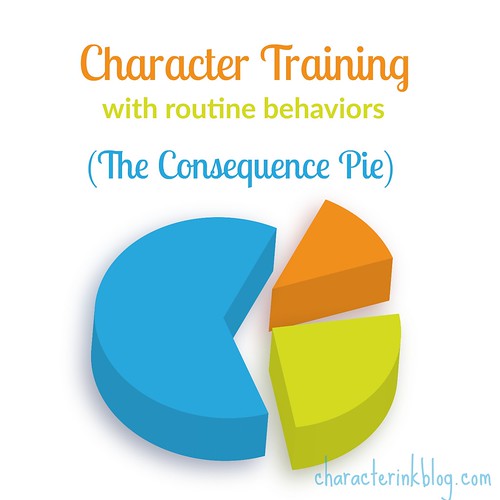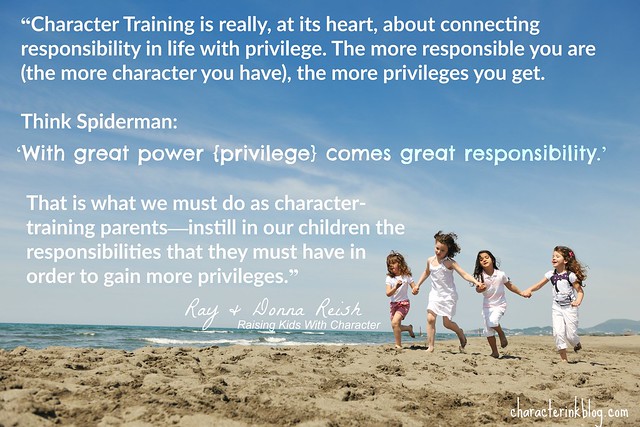 Listen to the podcast here!
Listen to the podcast here!
Introduction
1) Kevin Leman’s book Making Kids Mind Without Losing Yours—introduction to Reality Discipline
2) Link responsibility with privilege—get the responsibility level up to the ability level. (Read “The One Parenting Practice That Changes Everything.”)
Four D’s vs. Character Training
1. Be sure you understand the Four D’s of Behavior—the seriousness of them, the effect that they have on a child’s future relationships/life, the difference in handling them compared to character/routine training. (Listen to The Four D’s of Behavior; listen to Dealing With Heart Issues of Tweens.)
2. Determine how you will handle The Four D Behaviors first—and be sure these are your focus. (Yes, completing assignments and doing chores on time are important, but those do not compare with respect, submission, honesty, and kindness.)
Understand Character Behaviors/Routine Behaviors
1. Not Four D’s
2. Routine sums it up
3. Character qualities for living—responsibility, orderliness, thoroughness, diligence, neatness, timeliness, resourcefulness, etc.
4. Deficiencies usually show up in “routine” behaviors—not finishing homework, not cleaning bedroom, not doing chores on the chore chart, turning in poor work (without trying hard), etc.
Keys to Solving Character Behaviors/Routine Behaviors
1) All discipline problems are better solved (Four D’s and Routine) when a behavior is taken from gray to black & white. (Again, listen to podcasts on Four D’s and Handling Heart Behaviors to hear more of making behaviors black & white.)
2) In character training, that means, taking something from routine (chore time) to direct (it is chore time; when you are done with those four tasks, come to me).
3) Character/Routine Behaviors that are not done can be handled well with consequences that fit the infraction (“reality discipline”)
4) Reality discipline = the reality of the situation (for adulthood and other times in child’s life) is that you don’t get the reward of that (money, stable family, clean house, etc.)—this in smaller scale (with lots of training and rewards) also works for children
Character/Routine Behaviors Should Follow Systematic Order
1) Teach the skill or result you want thoroughly…every single step of the way!
2) Provide ample time to learn (allow learning curve time in which your involvement goes from heavy/full to lighter then none)
3) Provide visuals/reminders/steps/lists (if not always, at least at first for that behavior or skill)
4) Reward for follow through (i.e. stickers then family reward for new chore chart; chart for independent work filled in equals ice cream with Dad, etc.)
5) Reduce reward as child becomes proficient, reminding child we don’t get rewards for all the things we do in life
6) If still not doing it, take it from gray (routine…everybody should be doing independent work now) to black and white
a. One or two tasks then report to Mom
b. Direct instruction for longer
c. Consequence Pie
Using the Consequence Pie*
(see Printables “Consequence Pies for Character Training”)
1. Determine (with spouse, if possible) ahead of time what behaviors/routine problems are the most troublesome. (Pick one, two, or three**, depending on age: getting on computer before school is done; writing too sloppy on math pages; not taking trash down on Thursday nights; not cleaning room on Saturday mornings; working too slowly during family work time; etc.)
2. Meet with the child (with both parents whenever possible). With your child, come up with a list of the two (for four piece pie), three (for six piece pie), and four (for eight piece pie) most favorite things that the child enjoys doing. Write these down on the Consequence Pie in the order that he likes them least to greatest in the blanks (not pieces marked GRACE). In other words, if his least favorite of the three is watching a movie on Friday nights, put that in #2 piece; then his middle one is watching Youtube videos, put this on #4 piece; and his favorite is playing computer games after school for half an hour, put that in #6.
3. Explain the behaviors and the EXACT expectations. (See expectation explanations at our blog and listen to Terms and Concepts From a Raising Kids With Character Parenting Seminar.) Write these on the bottom of the Consequence Pie Sheet.
4. Have your child repeat back to you the behaviors that are expected, including the details (time, duration, number of problems that must be done, etc.—whatever that might be).
5. Explain the Consequence Pie system to him. (See sample explanation below.)
6. When the first infraction is committed, have your child go and physically move the spinner to the next pie piece and use a permanent marker to put an X on that piece. (Do not do it for him. Tell him, “You didn’t finish school today before you began playing, so go move the spinner and put an X on Piece #1.” No discussion. No begging. Remove yourself from the situation and let him go mark it.)
7. When the next infraction is committed, do the same as the previous step except say, “You forgot the trash again. Go move the spinner over to #2 and put an X on it. No movie on Friday night.” (End discussion.)
8. Continue in this manner until it gets close to his ultimate favorite. (This is why you might need an eight piece pie if your child is characterized by not obeying or following through. Also, if he is characterized by that, limit the number of behaviors you are working on at the time to one or two.)
*This idea was adapted from a short presentation I heard in church many years ago. I looked it up online, but I cannot find it. I believe it was called Smart Parenting. I have made several changes to it in order to make it consistent with our Raising Kids With Character seminar foundations, but I did want to point out that the original idea came from elsewhere.
**Whether you use the four, six, or eight piece Consequence Pie will be determined by many things:
a. Age of child—just choose one behavior and the four piece pie for younger children (or the six piece if behaviors are really out of control in that area).
b. Number of behaviors—if you are working on, responsibility, for example, and you want to work on three areas for your older teen (taking down the trash, finishing school by 2:00 without doing anything else except for his break, and doing evening chores between 4:00 and 4:30 without being reminded), you could use the eight piece pie and include all three behaviors on the list.
Sample Explanation of the Consequence Pie
“We are going to be working on some character issues with you. Specifically, we want you to change this one behavior (name it) or these two or three behaviors (name them). We have already trained you in your task. We have already rewarded you for doing them. Now it is time for you to make them your own. We will determine together what the consequences will be, and we will use this pie (the listing of things and the marking off of consequences) to help you learn to make these good behaviors your own, rather than the negative behaviors that we have been having.”
 Listen to the podcast here!
Listen to the podcast here!





